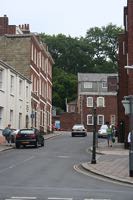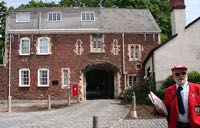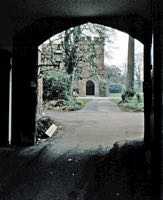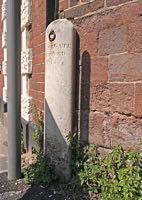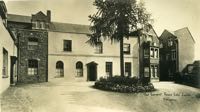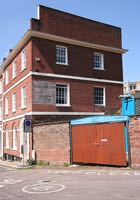
Palace Gate
Page updated 23rd October 2016
 Palace Gate Street leads into Cathedral Close and the gateway for the Bishops Place. There was once a public house in Palace Gate, appropriately named the Peter Bell. It was demolished in 1811 to widen the roadway; once, the street was a regular route for stage-coaches leaving and arriving the Royal Clarence Hotel and the Globe Hotel.
Palace Gate Street leads into Cathedral Close and the gateway for the Bishops Place. There was once a public house in Palace Gate, appropriately named the Peter Bell. It was demolished in 1811 to widen the roadway; once, the street was a regular route for stage-coaches leaving and arriving the Royal Clarence Hotel and the Globe Hotel.
Sir Walter Raleigh's parents lived in a house in Palace Gate towards the end of their lives. Palace Gate was a popular place to live for the merchants of the city. When John Baring married his wife Elizabeth, he commenced his life as a merchant in Palace Gate. The wool merchants, the Kennaway family exported serge to Spain and Portugal and, from 1743, imported wine, sherry and port. When the woollen trade collapsed in the 1770s, they concentrated on wine imports, centred on buildings in Palace Gate. Once, barrels of wine would be stacked outside the premises, on the pavement, ready for shipment, or to be stored in the cellars. The Kennaways closed their wine business in Palace Gate in 1975.
The further away from the Westquarter, the less likely the risk of cholera in the 1832 outbreak, with Palace Gate accounting for one death out of 402 for Exeter. Walk across South Street from Palace Gate into Coombe Street and the story is very different with 23 deaths from the disease. That did not stop Bishop Philpotts making sure he had business in Exmouth, during the outbreak.
In a June 1878 a report in the Western Times reported on a discovery, when Kennaways were enlarging their wine cellars:
“Ancient Remains.—In the course of the excavations made in Palace-gate for the construction of wine cellars a discovery has been made of a number skeletons, fragments of ancient pottery, bronze articles, and some coins of a date not later than the second century. We believe a gentleman of the City is likely to call particular attention to this discovery in a paper to be read at the approaching meeting of the Devonshire Science Association at Paignton.“
Later investigation suggested that the human remains may have been from a grave yard associated with St James’ Church that was recorded on the corner of Place Gate and South Street.
Palace Gate Convent School was run by nuns from 1896, when they left France in fear of Civil War. The chapel was designed and added in 1928 by Octavius Ralling, who was also the architect for the Oddfellows Hall in Catherine Street. The school closed in 1996.
An elderly woman was summonsed for soliciting in Palace Gate, in 1893, when she was seen by a policeman as she caught hold of "mere lads" and said "Come along my dear." The Mayor said the woman was "leading a very wretched life" and promptly sent her to prison for fourteen days. Such poverty and deprivation at the door of the bishops house.
Sources: Devon Life, British Newspaper Archive.
│ Top of Page │
